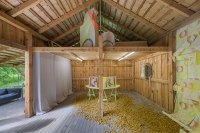Epifania Parerga
Polana Institute
May 29–30, 2021
Petrykozy
Epifania's surname, Parerga (plural of Parergon), is, according to the dictionary definition, 'decoration', 'embellishment', or 'accessory'. Something that functions in-between and at the same time becomes a fringe area. It is a place of confinement and suppression, which operates on the principle of a compressed spring. Boom. Something breaks. Something else spills out. And it squeezes between the image and the frame, tangible but also Derridean, derived from Kant. It bursts male narratives. This is not a male Parergon; Parerga is a girl. She is feisty and cocky, captivates with the boldness of her opinions, does not tolerate opposition, and is easily sharp-tongued. Sometimes she lies, other times she deceives – she says whatever comes to her mind.
It's just another tale about someone who never came to be. A fabricated story about someone who never existed. It is a woven story. Just like in Barthes, it is made through constant weaving, where the subject is lost in the texture and disintegrates like a spider in the secretions of its own web. Parerga is not only the name of our protagonist, but also a term for side works that are little known, existing 'somewhere out there', outside the mainstream. Like the works of artists who only become known after their death or in the non-existent future. It is something additional, something that is there, and yet it could not be. And there is nothing peculiar about it. The curtain – or kołtryna – has fallen.
Epifania's biography sounds completely made up and maybe it is. It's a bizarre conglomeration of authentic and fictional stories, old movies and abstract concepts. Unsigned works and projects. Biographies of women artists employed in Żyrardów, such as Joanna Hasior, the ex-wife of the famous Polish artist, but also others such as Józefa Wnukowa, a painter and weaver and the founder of the 'Sopot School', or Anna Fiszer, an employee of the Institute of Industrial Design, whose abstract mosaic was demolished and carried away only a few years ago. Biographies of women who left behind nothing but a print on fabric and those who didn't even leave that.
Anna Batko
Photography: Jędrzej Sokołowski











